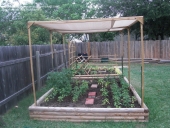John makes some great points.
Drip irrigation is the way to go for landscape plants. After years of experimentation, I found that
T-tape was best for annuals like veggie beds.
You want to make sure your drip irrigation is UNDER the mulch. Otherwise, the carbonaceous mulch (woodchips, cardboard, newspaper) will wick up all the moisture and the plants below may not get the water you think they're getting.
Here's my process for using a thick carbon-material mulch in the desert:
1. Install plants.
2. Install irrigation (either drip emitters or t-tape depending on type of plant)
3. Water area thoroughly. Often, because I garden in sunken beds and infiltration basins as part of an overall water harvesting strategy, I turn on the hose and flood the area and let it sink in.
4. Load up your mulch materials into a wheelbarrow and water them down well, also. Usually my woodchip pile is in the alley. So I load up the wheelbarrow about 3/4 full then as I walk past the hose, I turn it on the chips, then I spread the chips 4-8 inches thick on top of the soil and drip system of choice.
Why do I do this?
--Living in the arid SW - things dry out quickly. Giving the plants a good watering in the soil prior to putting the mulch on top makes sure there's moisture to hold in.
--Wetting down the mulch when putting it down helps stop the initial wicking effect that carbon mulch has on soils - where it will actually pull moisture out of the soil until it has what it needs. Putting a dry carbon mulch on dry desert soils can actually exacerbate drying out of the soil initially and plants might look wilty.
--having the irrigation between the soil and the mulch (not on top of the mulch) guarantees that much of your water will go down into the soil instead of being dispersed into the woodchips as it would be if the irrigation was on the top. The key interaction for soil making is that area where the woodchips meet the soil in that moistened area. The woodchips will decay through the interaction at that location. The top of the woodchips will become dry and silvery, but underneath, they will create those wonderful fungal nets that are so beneficial. A little good
compost sprinkled on the soil before adding the carbon mulch will help speed things along.
Be aware that FRESH woodchip piles will start growing fungal nets right away. However, if you let the pile sit for even a little while and don't keep it wet, these will start to die off. When you dig into the pile, a grey "smoke" plumes up from the pile (dead fungal bodies? spores??) Anyway, MANY people I know are respiratorily sensitive to this so please wear dust masks and wash the clothes you wore to not spread this around.





 1
1





 2
2








 1
1








 1
1




 2
2




 1
1




 2
2








 2
2


























